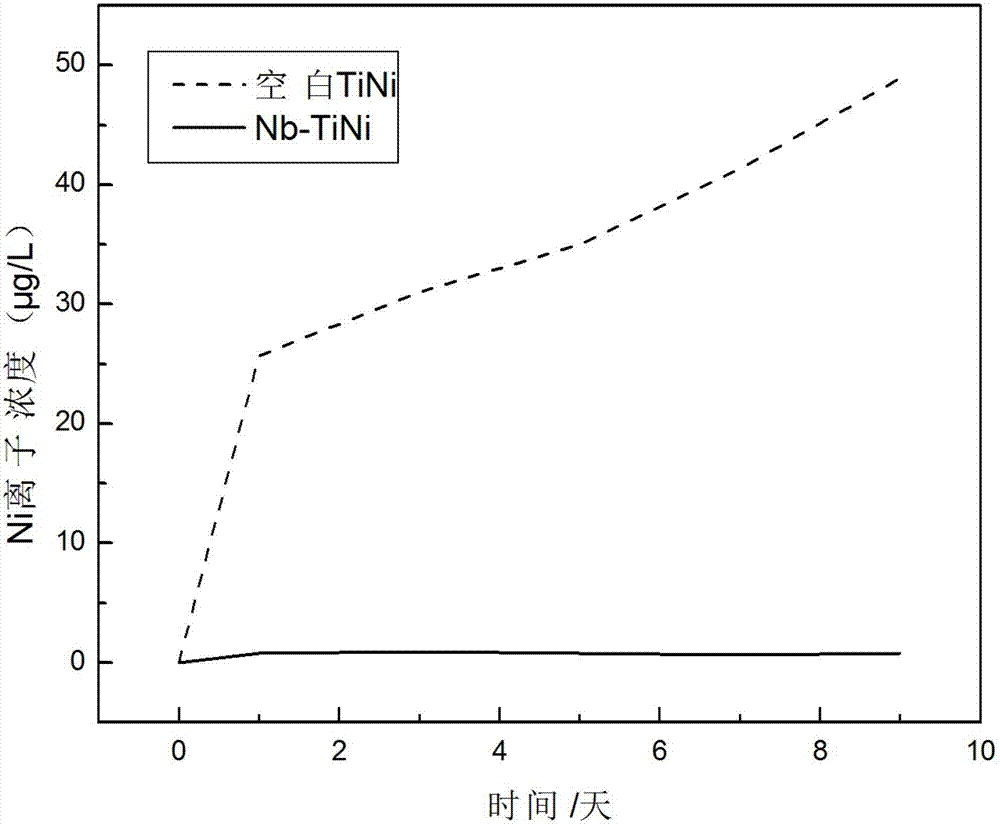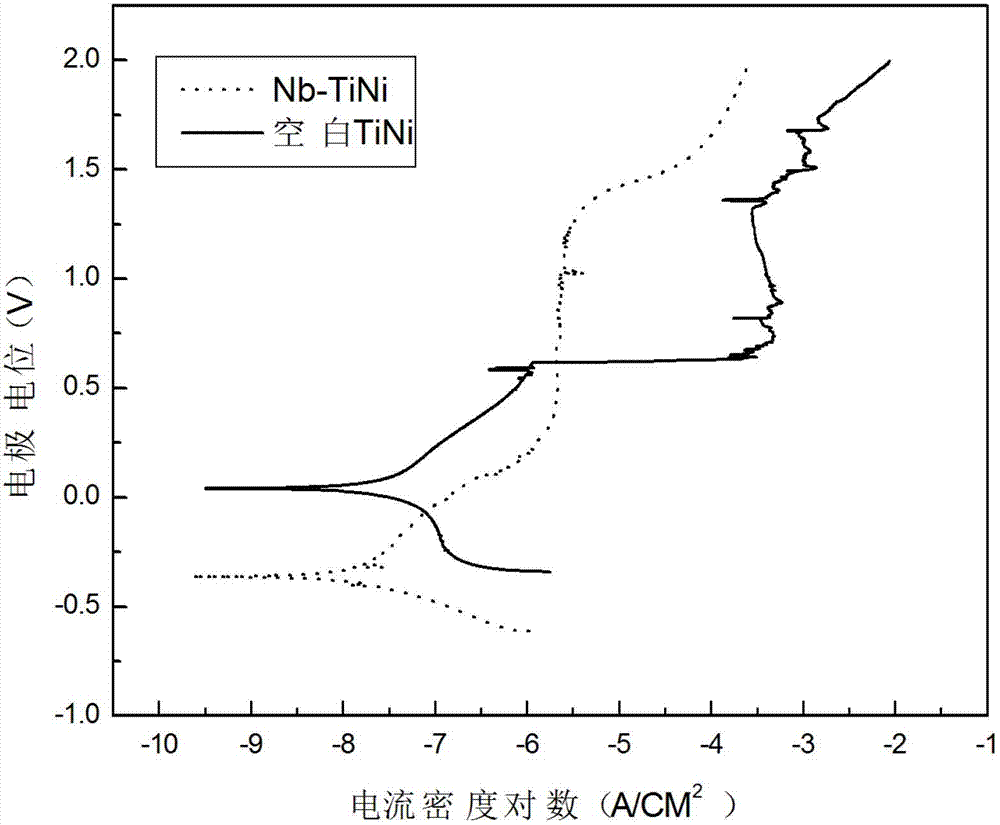Method for conducting surface modification on medical titanium nickel (TiNi) shape memory alloys through niobium (Nb) ion injection deposition
A memory alloy and ion implantation technology, applied in ion implantation plating, metal material coating process, coating, etc., can solve the problems of reduced biocompatibility, difficulty, poor local corrosion resistance, etc., and achieve improved biocompatibility Sexuality, reduced toxicity, good binding strength
- Summary
- Abstract
- Description
- Claims
- Application Information
AI Technical Summary
Problems solved by technology
Method used
Image
Examples
Embodiment 1
[0040] The first step: pretreatment of the substrate:
[0041] Select the TiNi shape memory alloy matrix with equal atomic ratio, after grinding and polishing, ultrasonic cleaning with absolute ethanol, acetone and deionized water for 10 minutes to prepare the sample;
[0042] Step 2: Preparation of oxide transition layer by ion implantation:
[0043] (A) Put the sample prepared in the first step into a metal vapor vacuum arc ion source ion implanter for argon ion sputtering to remove surface impurities; where the vacuum degree is 0.3×10 -3 Pa, voltage energy 5KeV, time 15min;
[0044] (B) The sample treated with argon ion is doped with Nb element to prepare a sample with a transition layer; the required parameters for doping with Nb element: vacuum 0.1×10 -3 Pa, niobium Nb element dose 1.0×10 17 ion / cm 2 , Energy 50KeV, current 1.5mA;
[0045] The third step: ion beam enhanced deposition technology to prepare the surface layer of Nb film:
[0046] When depositing film, the ion source an...
Embodiment 2
[0061] The first step: pretreatment of the substrate:
[0062] Select the TiNi shape memory alloy matrix with equal atomic ratio, after grinding and polishing, ultrasonic cleaning with absolute ethanol, acetone and deionized water for 10 minutes to prepare the sample;
[0063] Step 2: Preparation of oxide transition layer by ion implantation:
[0064] (A) Put the sample prepared in the first step into a metal vapor vacuum arc ion source ion implanter for argon ion sputtering to remove surface impurities; where the vacuum degree is 0.1×10 -3 Pa, energy 5KeV, time 15min;
[0065] (B) The sample treated with argon ion is doped with Nb element to prepare a sample with a transition layer; the required parameters for doping with Nb element: vacuum degree 2×10 -3 Pa, niobium Nb element dose 1.0×10 17 ion / cm 2 , Energy 80KeV, current 2mA;
[0066] The third step: ion beam enhanced deposition technology to prepare the surface layer of Nb film:
[0067] When depositing film, the ion source and spu...
Embodiment 3
[0072] The first step: pretreatment of the substrate:
[0073] Select the TiNi shape memory alloy matrix with equal atomic ratio, after grinding and polishing, ultrasonic cleaning with absolute ethanol, acetone and deionized water for 8-10 minutes to prepare samples;
[0074] Step 2: Preparation of oxide transition layer by ion implantation:
[0075] (A) Put the sample prepared in the first step into a metal vapor vacuum arc ion source ion implanter for argon ion sputtering to remove surface impurities; where the vacuum degree is 0.1×10 -3 Pa, energy 5KeV, time 30min;
[0076] (B) The sample treated with argon ion is doped with Nb element to obtain a sample with a transition layer; the required parameters for doping with Nb element: vacuum degree 1×10 -3 Pa, niobium, Nb element dose 1.5×10 17 ion / cm 2 , Energy 100KeV, current 4mA;
[0077] The third step: ion beam enhanced deposition technology to prepare the surface layer of Nb film:
[0078] When depositing film, the ion source and spu...
PUM
| Property | Measurement | Unit |
|---|---|---|
| thickness | aaaaa | aaaaa |
Abstract
Description
Claims
Application Information
 Login to View More
Login to View More - R&D
- Intellectual Property
- Life Sciences
- Materials
- Tech Scout
- Unparalleled Data Quality
- Higher Quality Content
- 60% Fewer Hallucinations
Browse by: Latest US Patents, China's latest patents, Technical Efficacy Thesaurus, Application Domain, Technology Topic, Popular Technical Reports.
© 2025 PatSnap. All rights reserved.Legal|Privacy policy|Modern Slavery Act Transparency Statement|Sitemap|About US| Contact US: help@patsnap.com


